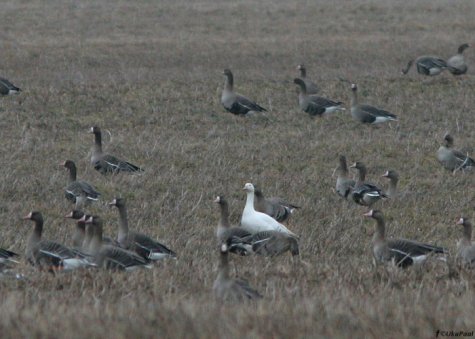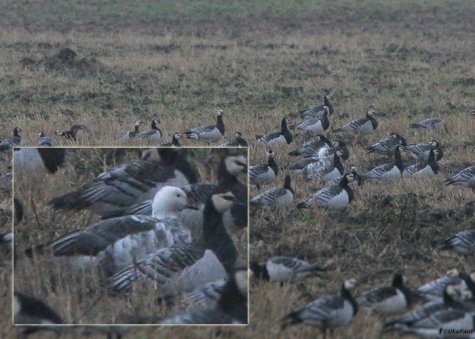Good time for geese
Text: Uku Paal, Estonian Committee for Bird Rarities www.estbirding.ee
Photos: Arne Ader and Uku Paal
Translation: Liis
Bean goose with domestic geese.
This year’s floods promise good conditions for the migration stop-over of geese, and we can hope to see many of them this year. Interesting individuals often appear in the large flocks. A particularly eagerly looked for event is seeing a snow goose, very rare here, or the even rarer lesser snow goose. The Estonian Bird Rarities Committee has steadily had problems with the evaluation of the “white geese” observation form. Here are a few hints about some of the pitfalls in identifying “white geese”.
When a white goose is observed there are several possibilities to keep in mind on identifying the bird:
a) Exclude domestic geese! Black wing primaries are a hint that it may be a snow goose or lesser snow goose.
b) Exclude the possibility of an albino individual! Some photos here illustrate the problem:
c) Exclude the possibility of a hybrid! A diligent goose watcher meets several of them every spring. Often they cannot be identified, even with good photo documentation at hand. The hybrids cause headaches particularly when identifying „blue geese” (the blue variety of snow geese). Hybrids with a blue variety of snow goose or lesser snow goose as one parent are often impossible to distinguish from “pure” individuals. It should be noted that the blue variety of lesser snow goose is extremely rare.
On the photo is an individual reminding of a "blue goose”:
d) Two species of “white geese” occur in Estonia!
Distinguishing between snow goose (Anser caerulescens) and lesser snow goose (Anser rossii) is a permanent problem even for experienced observers, since the subject has been treated only superficially in field guides (even in the new Collins). The size of the bird is a good clue, but not a definite distinguishing characteristic! The size of geese varies widely. The sizes of the snow goose caerulescens subspecies and of the lesser snow goose partly overlap.
Distinguishing between snow goose (Anser caerulescens) and lesser snow goose (Anser rossii) is a permanent problem even for experienced observers, since the subject has been treated only superficially in field guides (even in the new Collins). The size of the bird is a good clue, but not a definite distinguishing characteristic! The size of geese varies widely. The sizes of the snow goose caerulescens subspecies and of the lesser snow goose partly overlap.
First of all the description of the beak should be noted. The two species have different beak shapes and the colours also differ. The lesser snow goose has a characteristic short beak with a narrow black edge. This lends the lesser snow goose a “loveable face”. The colouring of the upper mandible is clear evidence: the root has a blue-grey area, lacking in snow geese.
The beak of the snow goose is more elongated and the edge has a broad black band that gives the snow goose a “grinning” expression. The base of the upper mandible is pink-coloured. Very large individuals presumably belong to the larger atlanticus subspecies, but determining subspecies is risky.
Photographing geese by the digiscope method is simple. With rare individuals it is certainly always worth getting a photo.
Additional reading:
http://www.surfbirds.com/Features/nikonsnowgeese0210/snowrossgoose.html












